Natural and Human-Induced Dynamics on Big Hickory Island, Florida
Abstract
:1. Introduction
2. Experimental Section
2.1. Near-Term Shoreline Change Analysis Methods
2.2. Short-Term Shoreline Change Analysis Methods
- MHW shoreline survey along the northern portion of Big Hickory Island,
- Topographic and hydrographic beach profiles from R-222.5 to R-225.5 to the depth of closure,
- Wading depth (topographic only) profiles at the centerline of each groin cell, and
- Volumetric changes were also calculated to supplement the short-term dynamics analysis.
3. Results
3.1. Near-Term Shoreline Change
3.2. Short-Term Shoreline Change
3.3. Short-Term Volumetric Change
4. Discussion
Acknowledgments
Author Contributions
Conflicts of Interest
References
- Bird, E.C. The modern prevalence of beach erosion. Mar. Pollut. Bull. 1987, 18, 151–157. [Google Scholar] [CrossRef]
- Morton, R.A.; McKenna, K.K. Analysis and projection of erosion hazard areas in Brazoria and Galveston Counties, Texas. J. Coast. Res. 1999, 28, 106–120. [Google Scholar]
- Kraus, N.C.; Galgano, F.A. Beach Erosional Hot Spots: Types, Causes, Solutions; Engineer Research and Development Center: Vicksburg, MI, USA, 2001; pp. 1–17. Available online: http://citeseerx.ist.psu.edu/viewdoc/download?doi=10.1.1.492.7258&rep=rep1&type=pdf (accessed on 14 February 2016).
- Elko, N.A.; Mann, D.W. Implementation of geotextile t-groins in Pinellas County, Florida. Shore Beach 2007, 75, 2–10. [Google Scholar]
- CEM. Coastal Engineering Manual, Part V, Chapter 3; U.S. Army Corps of Engineers: Washington, DC, USA, 2002. [Google Scholar]
- Basco, D.R.; Pope, J. Groin functional design guidance from the Coastal Engineering Manual. J. Coast. Res. 2004, 33, 121–130. [Google Scholar]
- Van Rijn, L. Coastal erosion and control. Ocean Coast. Manag. 2011, 54, 867–887. [Google Scholar] [CrossRef]
- National Research Council. Beach Nourishment and Protection, Committee on Beach Nourishment and Protection; National Academies Press: Washington, DC, USA, 1995; p. 352. Available online: http://www.nap.edu/catalog/4984.html (accessed on 27 January 2016).
- Kraus, N.C.; Hanson, H.; Blomgren, S. Modern functional design of groins systems. In Proceedings 24th Coastal Engineering Conference; ASCE: New York, NY, USA, 1994; pp. 1327–1342. [Google Scholar]
- Donohue, K.A.; Bocamazo, L.M.; Dvorak, D. Experience with groin notching along the Northern New Jersey Coast. J. Coast. Res. 2004, 33, 198–214. [Google Scholar]
- Galgano, F.A. Long-term effectiveness of a groin and beach fill system: A case study using shoreline change maps. J. Coast. Res. 2004, 33, 3–18. [Google Scholar]
- Traynum, S.B.; Kana, T.W.; Simms, D.R. Construction and performance of six template groins at Hunting Island, South Carolina. Shore Beach 2010, 78, 21–32. [Google Scholar]
- Nordstrom, K.F. Beaches and dunes of human-altered coasts. Progr. Phys. Geogr. 1994, 18, 497–516. [Google Scholar] [CrossRef]
- Peterson, C.H.; Bishop, M.J. Assessing the Environmental Impacts of Beach Nourishment. BioScience 2005, 55, 887–896. [Google Scholar] [CrossRef]
- Roberts, T.; Wang, P. Four-year performance and associated controlling factors of several beach nourishment projects along three adjacent barrier islands, west-central Florida, USA. Coast. Eng. 2012, 70, 21–39. [Google Scholar] [CrossRef]
- Rahmstorf, S. A semi-empirical approach to projecting future sea-level rise. Science 2007, 315, 368–370. [Google Scholar] [CrossRef] [PubMed]
- Houston, J.; Dean, R. Erosional impacts of modified inlets, beach encroachment, and beach nourishment on the east coast of Florida. J. Coast. Res. 2015, in press. [Google Scholar] [CrossRef]
- Browder, A.E.; Dean, R.G. Monitoring and comparison to predictive models of the Perdido Key beach nourishment project, Florida, USA. Coast. Eng. 2000, 39, 173–191. [Google Scholar] [CrossRef]
- Davis, R.J.; Wang, P.; Silverman, B. Comparison of the performance of the three adjacent and differently constructed beach nourishment projects on the gulf peninsula of Florida. J. Coast. Res. 2000, 16, 396–407. [Google Scholar]
- Elko, N.A.; Holman, R.A.; Gelfenbaum, G. Quantifying the rapid evolution of a nourishment project with video imagery. J. Coast. Res. 2005, 21, 633–645. [Google Scholar] [CrossRef]
- American Shore and Beach Preservation Association (ASBPA). Reintroducing coastal structures for erosion control on the open coasts of America. Shore Beach 2011, 79, 62–67. [Google Scholar]
- Giannio, S.; Stevens, R.; Watts, G. Local financing for beach nourishment at Captiva Island, Florida. In Coastal Zone; Magoon, O., Converse, H., Miner, D., Clark, D., Tobin, L., Eds.; American Society of Civil Engineers: New York, NY, USA, 1985; Volume 85, pp. 2154–2170. [Google Scholar]
- Rudeen, K. Analysis of Proposed DeBordieu Groin and Beach Nourishment Project; Western Carolina University: Cullowhee, NC, USA, 2011; pp. 1–14. [Google Scholar]
- Walton, T.L. Littoral Drift Estimates along the Coastline of Florida; Sea Grant Report No. 13; Coastal and Oceanographic Engineering Laboratory, University of Florida: Gainesville, FL, USA, 1976. [Google Scholar]
- Dean, R.G. Investigation of Erosional Causes and Option for Big Hickory Island; Robert G. Dean: Gainesville, FL, USA, 2008. [Google Scholar]
- Dean, R.G. Compatibility of borrow material for beach fills. In Proceedings of the 14th Coastal Engineering Conference; American Society of Civil Engineers: New York, NY, USA, 1975; pp. 1319–1333. [Google Scholar]
- Morton, R.A.; Miller, T.; Moore, L. Historical shoreline changes along the US Gulf of Mexico: A summary of recent shoreline comparisons and analyses. J. Coast. Res. 2005, 21, 704–709. [Google Scholar] [CrossRef]
- Lentz, E.E.; Hapke, C.J.; Stockdon, H.F.; Hehre, R.E. Improving understanding of near-term barrier island evolution through multi-decadal assessment of morphologic change. Mar. Geol. 2013, 337, 125–139. [Google Scholar] [CrossRef]
- Weathers, H.D.; Voulgaris, G. Evaluation of beach nourishment evolution models using data from two South Carolina, USA beaches: Folly Beach and Hunting Island. J. Coast. Res. 2013, 69, 84–89. [Google Scholar] [CrossRef]
- Davis, R.A. Barriers of the Florida Gulf Peninsula. In Geology of the Holocene Barrier Island Systems; Davis, R.A., Ed.; Springer-Verlag: Berlin, Germany, 1994; p. 456. [Google Scholar]
- Hiland, M.; Byrnes, M.; McBride, R.; Jones, F. Change analysis and spatial information management for coastal environments. MicroStation Manag. 1993, 3, 58–61. [Google Scholar]
- Gorman, L.; Morang, A.; Larson, R. Monitoring the coastal environment; Part IV: Mapping, shoreline changes, and bathymetric analysis. J. Coast. Res. 1998, 14, 61–92. [Google Scholar]
- Boak, E.H.; Turner, I.L. Shoreline definition and detection: A review. J. Coast. Res. 2005, 21, 688–703. [Google Scholar] [CrossRef]
- Smith, G.L.; Zarillo, G.A. Calculating long-term shoreline recession rates using aerial photographic and beach profiling techniques. J. Coast. Res. 1990, 6, 111–120. [Google Scholar]
- Crowell, M.; Leatherman, S.; Buckley, M. Historical shoreline change: Error analysis and mapping accuracy. J. Coast. Res. 1991, 7, 839–852. [Google Scholar]
- Moore, L.J. Shoreline mapping techniques. J. Coast. Res. 2000, 16, 111–124. [Google Scholar]
- Moore, L.J.; Ruggiero, P.; List, J.H. Comparing mean high water and high water line shorelines: Should proxy-datum offsets be incorporated into shoreline change analysis? J. Coast. Res. 2006, 22, 894–905. [Google Scholar] [CrossRef]
- Florida Department of Environmental Protection (FDEP). Monitoring Standards for Beach Erosion Control Projects. 2014. Retrieved from Division of Water Resources, FDEP. Available online: http://www.dep.state.fl.us/beaches/publications/pdf/PhysicalMonitoringStandards.pdf (accessed on 19 December 2015).
- Dean, R.G.; Dalrymple, R.A. Field techniques and analysis. In Coastal Processes: With Engineering Applications; Davis, R.G., Dalrymple, R.A., Eds.; Cambridge University Press: Cambridge, UK, 2002; p. 47. [Google Scholar]
- Kraus, N.C.; Larson, M.; Wise, R.A. Depth of Closure in Beach-Fill Design, Coastal Engineering Technical Note CHTN II-40; U.S. Army Engineer Waterways Experiment Station, Coastal and Hydraulics Laboratory: Vicksburg, MI, USA, 1998. [Google Scholar]
- Jones, C. Big Hickory Pass, New Pass, and Big Carlos Pass Glossary of Inlets; Report No.8; Department of Coastal and Oceanographic Engineering, University of Florida: Gainesville, FL, USA, 1980. [Google Scholar]
- Church, J.A.; White, N.J. Sea-level rise from the late 19th to the early 21st Century. Surv. Geophys. 2011, 32, 585–602. [Google Scholar] [CrossRef]
- Olsen Associates Inc. Bonita Beach—Beach Restoration Project, Six-Months Post Construction Monitoring Report; Bureau of Beaches and Coastal Systems, Florida Department of Environmental Protection, and the Lee County Board of County Commissioners: Jacksonville, FL, USA, 1996. [Google Scholar]
- Dean, R. Cross-shore sediment transport processes. In Advances in Coastal and Ocean Engineering; Philip Liu, L., Ed.; World Scientific: Singapore, Singapore, 1995; pp. 159–220. [Google Scholar]
- Dean, R.G. Beach nourishment, theory and practice. In Advanced Series on Ocean Engineering; World Scientific: Singapore, Singapore, 2002; Volume 18, p. 399. [Google Scholar]
- Slott, J.M.; Murray, A.B.; Ashton, A.D.; Crowley, T.J. Coastline responses to changing storm patterns. Geophys. Res. Lett. 2006, 33, L18404. [Google Scholar] [CrossRef]
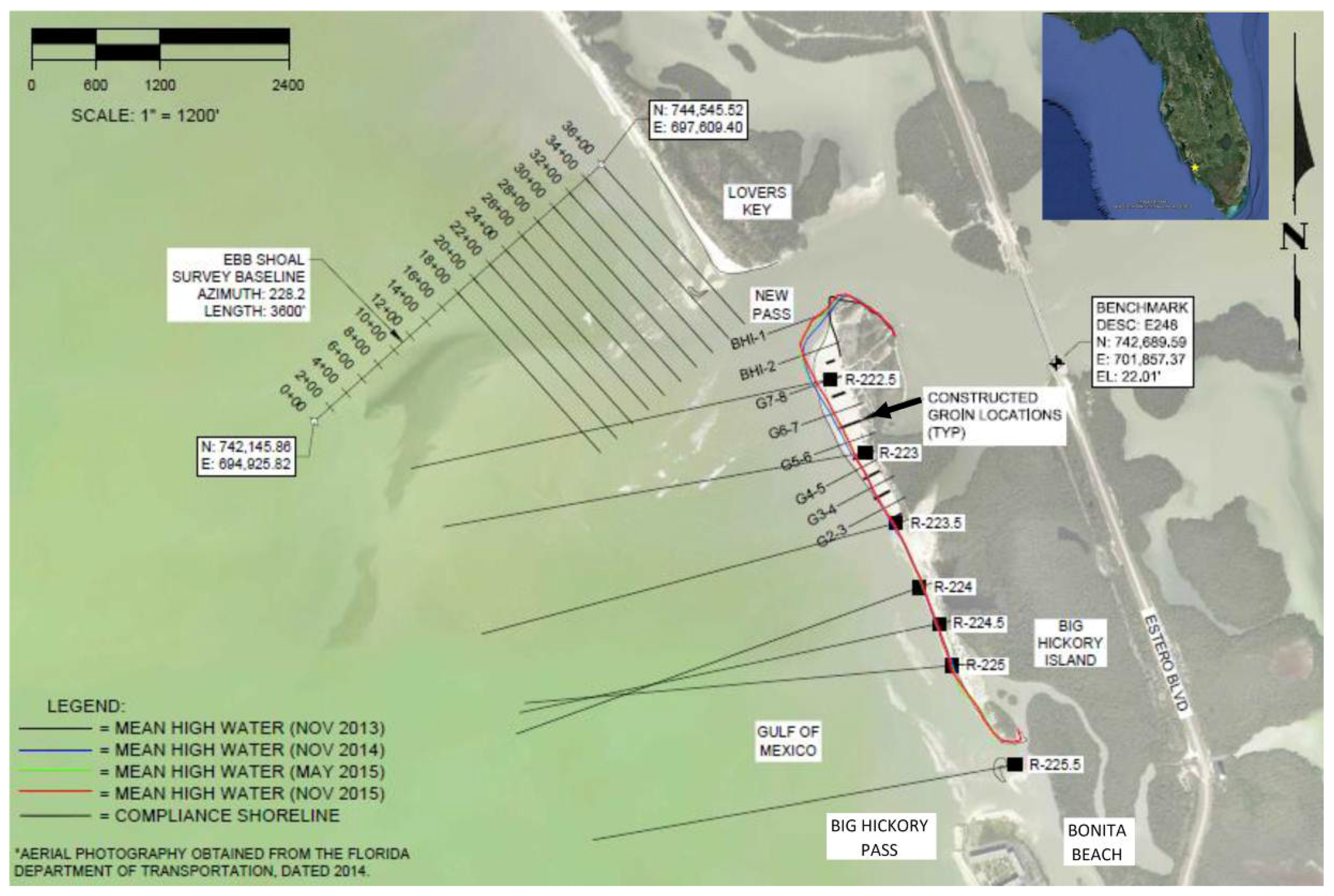

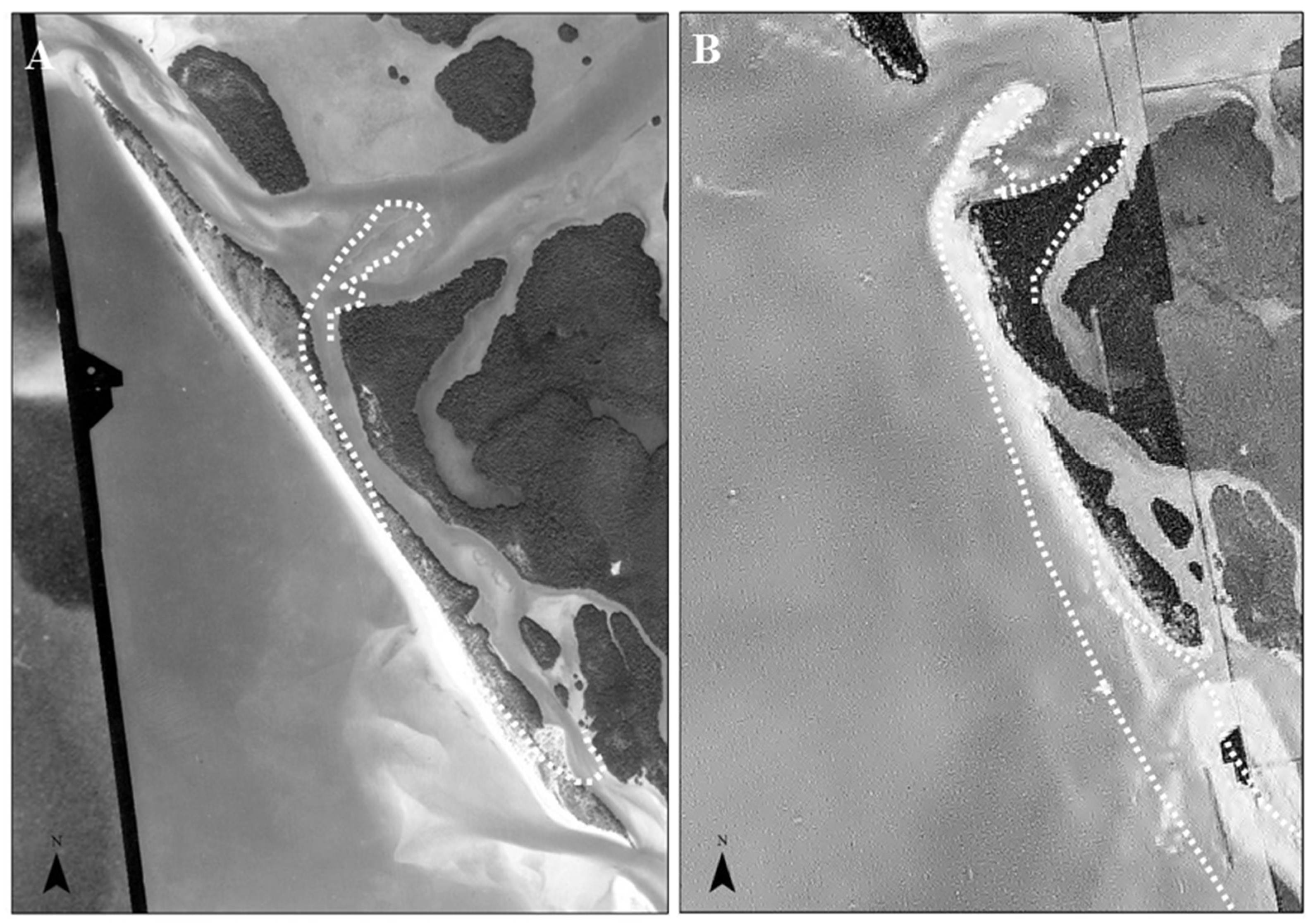
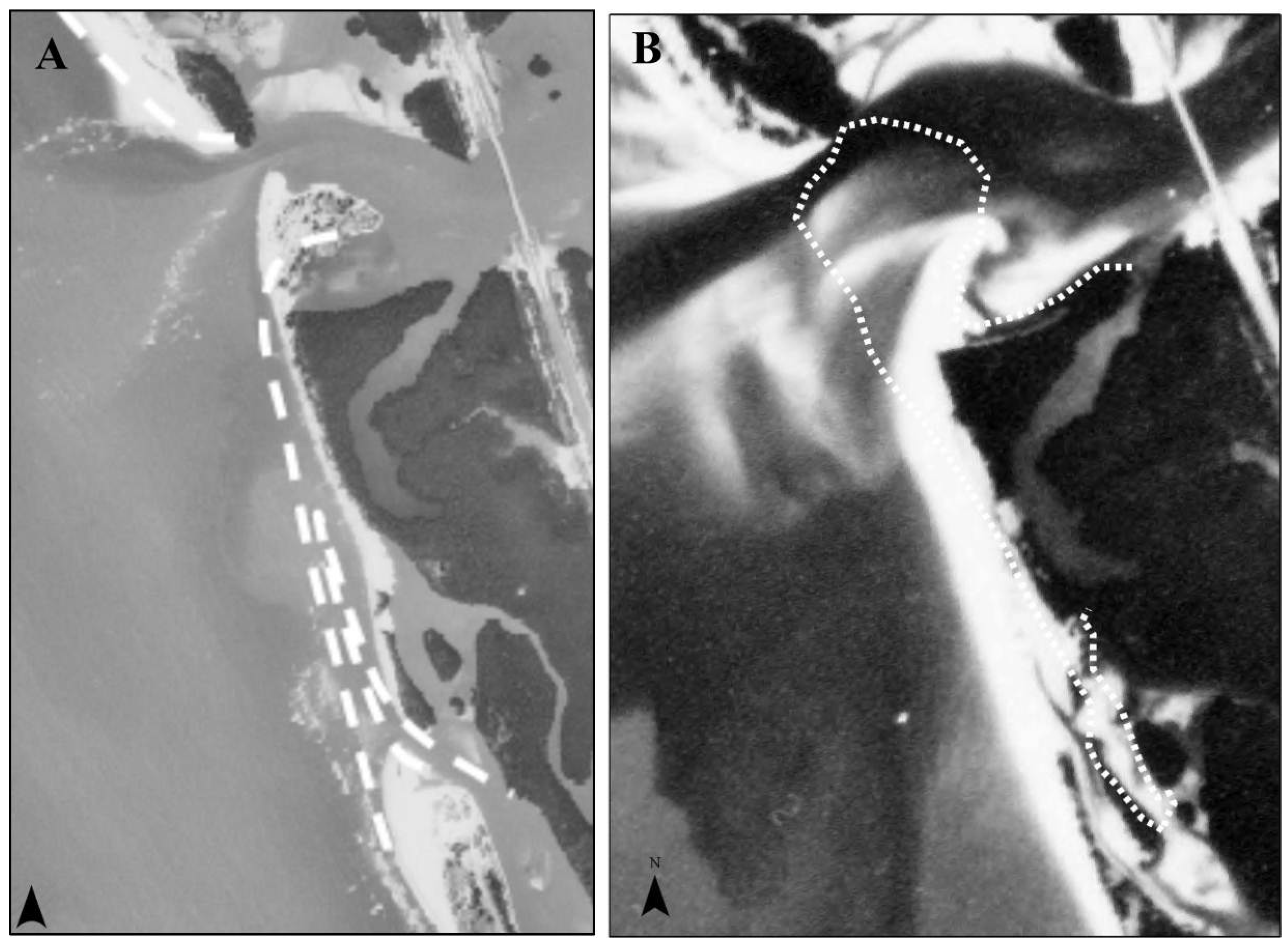
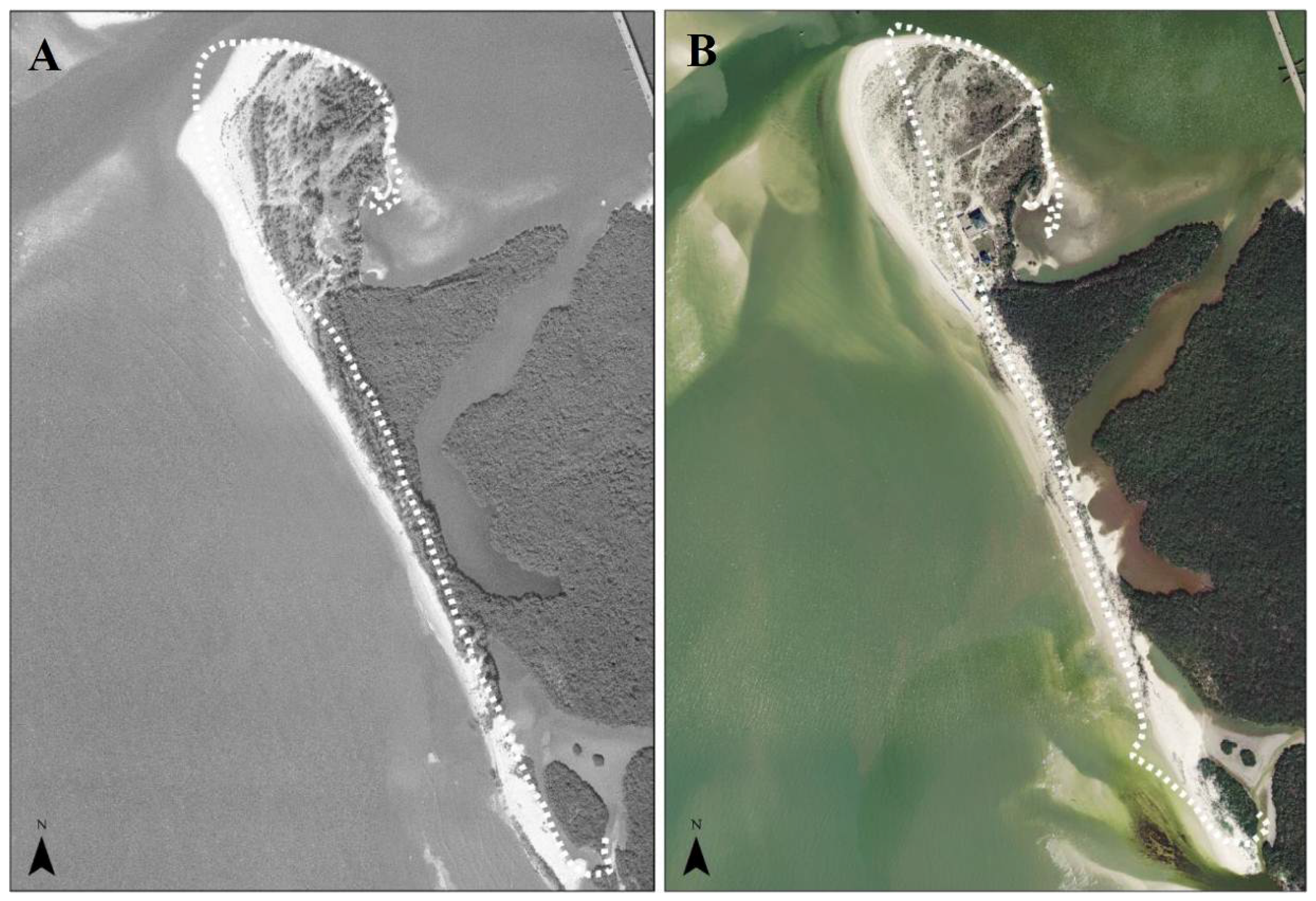
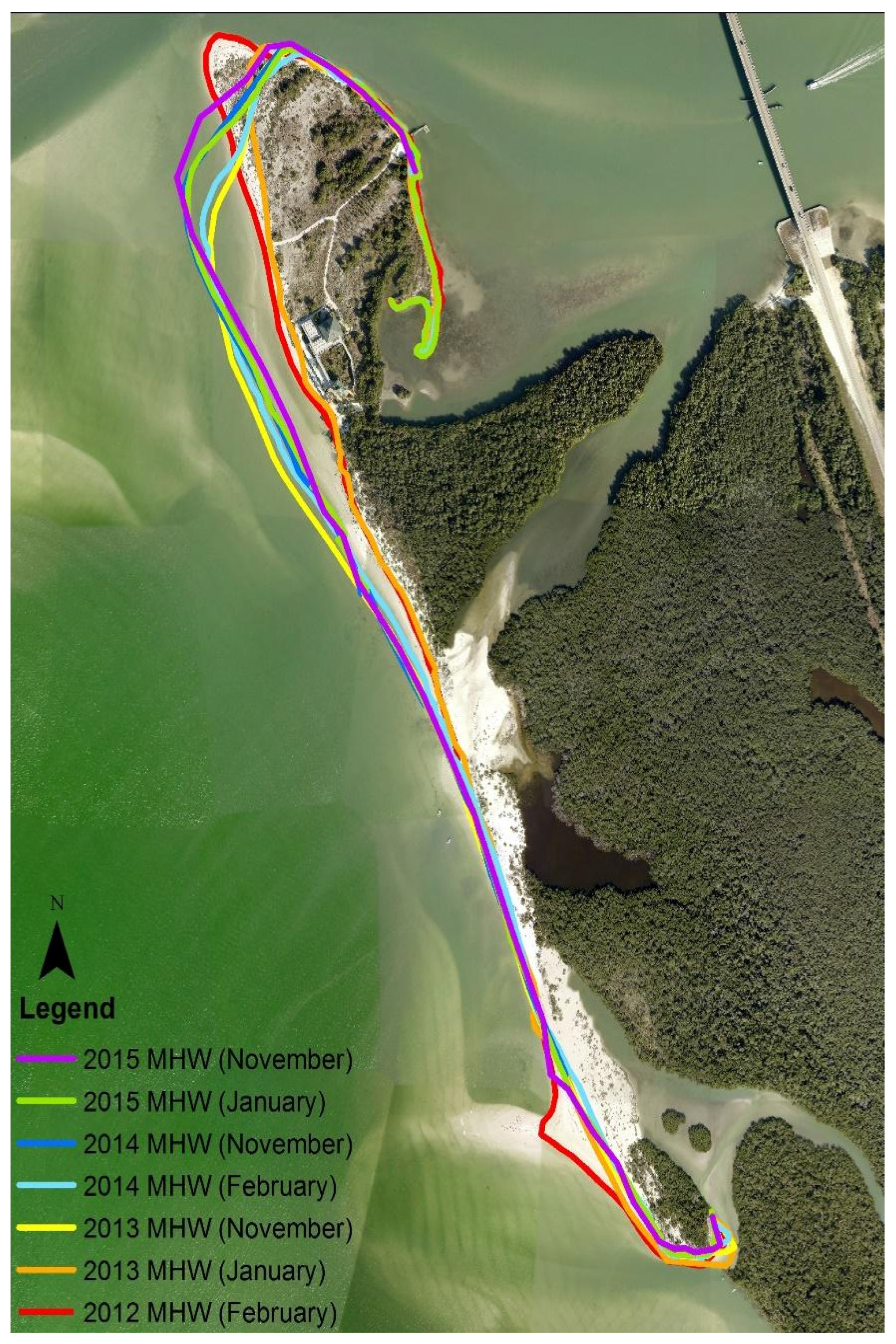
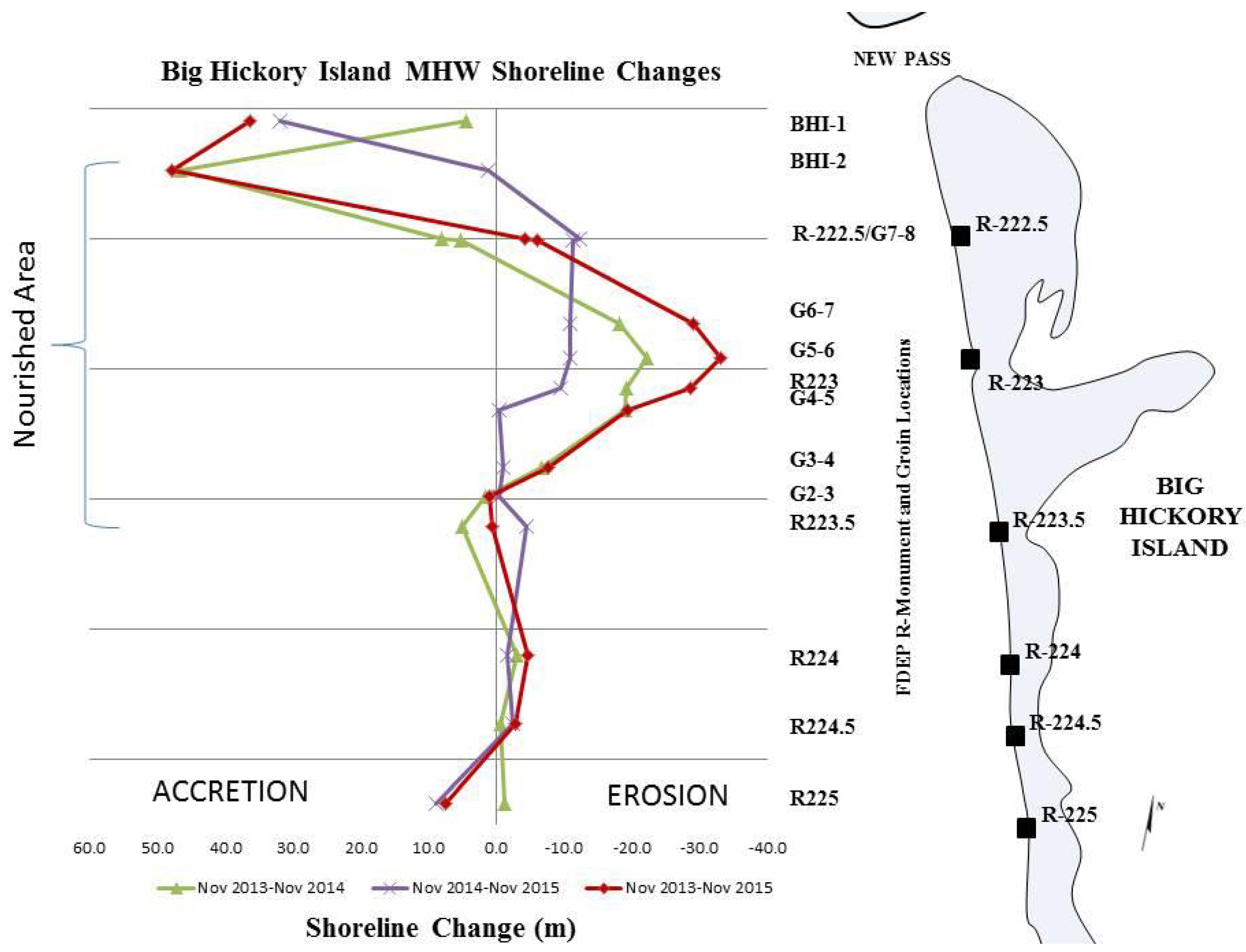
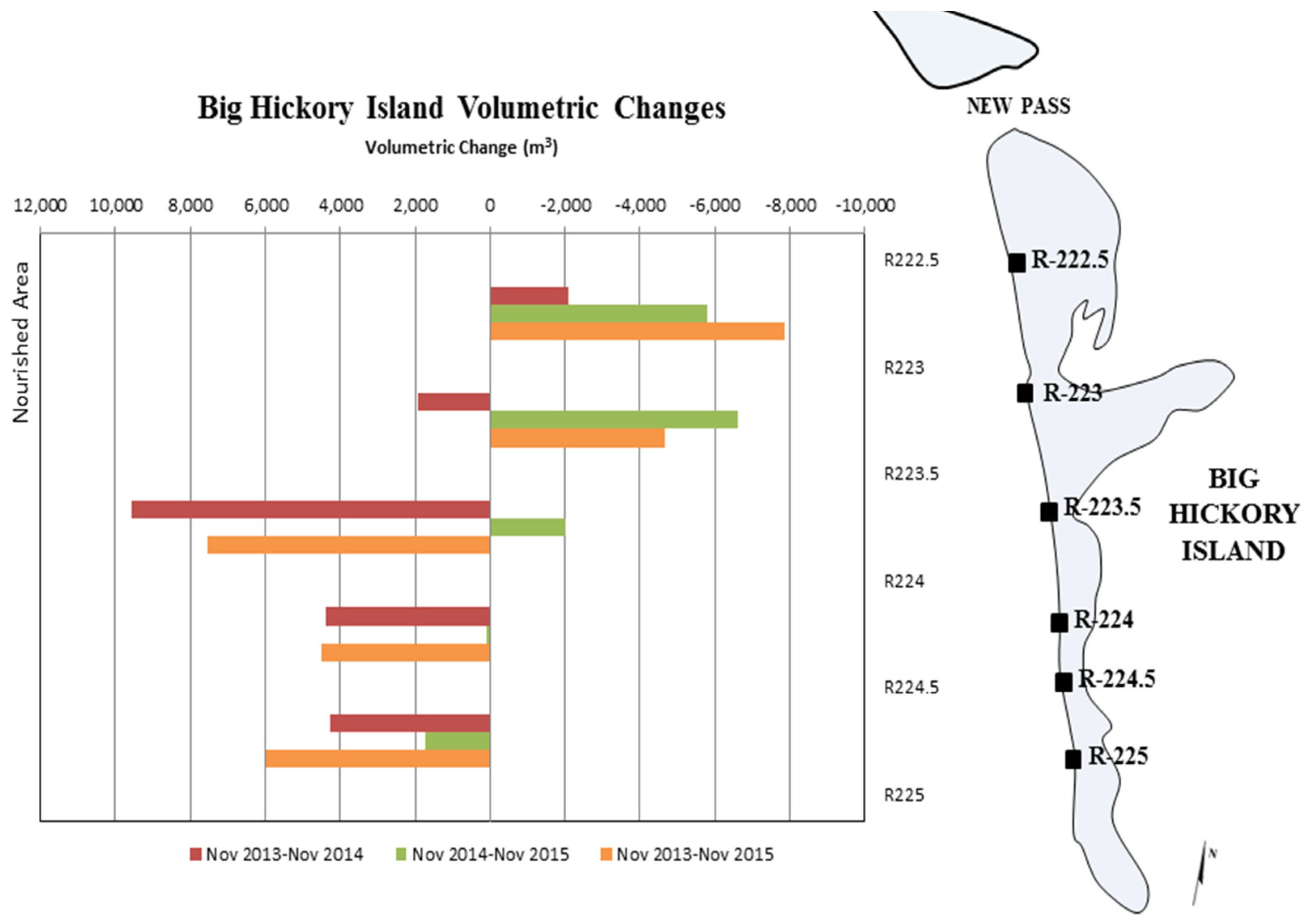
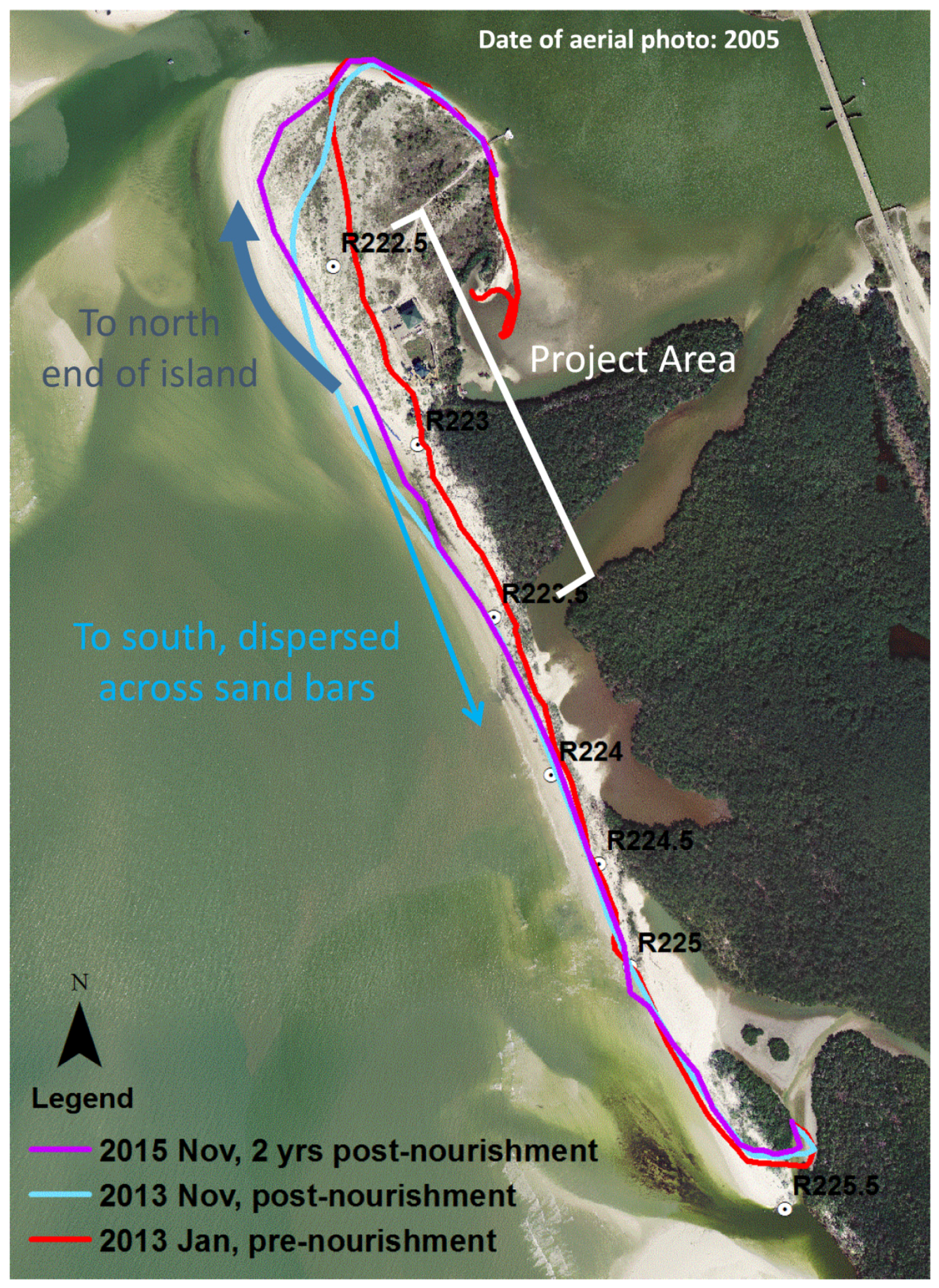
| MON | MHW Position | MHW Position | MHW Position | Total Change |
|---|---|---|---|---|
| 2013-Nov (m) | 2014-Nov (m) | 2015-Nov (m) | Nov 2013–Nov 2015 (m) | |
| R222.5 | 46.0 | 54.1 | 41.9 | −4.1 |
| R223 | 58.4 | 39.3 | 29.8 | −28.6 |
| R223.5 | 7.4 | 12.4 | 7.9 | 0.5 |
| R224 | −7.1 | −10.1 | −11.7 | −4.6 |
| R224.5 | 8.6 | 8.1 | 5.7 | −2.9 |
| R225 | −1.6 | -3.0 | 5.9 | 7.5 |
| Average (Standard Deviation, ) | −5.4 (12.2) |
| Groin Line | MHW Position | MHW Position | MHW Position | Total Change |
|---|---|---|---|---|
| 2013-Nov (m) | 2014-Nov (m) | 2015-Nov (m) | Nov 2013–Nov 2015 (m) | |
| G2-3 | 68.8 | 70.4 | 69.9 | 1.1 |
| G3-4 | 79.6 | 73.0 | 72.0 | −7.6 |
| G4-5 | 88.8 | 70.0 | 69.4 | −19.4 |
| G5-6 | 110.0 | 87.9 | 77.0 | −33.0 |
| G6-7 | 117.3 | 99.2 | 88.3 | −29.0 |
| G7-8 | 104.4 | 109.7 | 98.4 | −6.1 |
| BHI-1* | −9.2 | −4.8 | 27.0 | 36.2 |
| BHI-2* | 61.1 | 107.7 | 109.0 | 47.9 |
| Average change within the groin field () | −15.7 (4.2) | |||
| Average change including north end () | −2.8 (8.9) | |||
| MON | Volume (m3) | ||
|---|---|---|---|
| Nov 2013–Nov 2014 | Nov 2014–Nov 2015 | Total | |
| R222.5 | |||
| −2085 | −5778 | −7863 | |
| R223 | |||
| 1926 | −6603 | −4678 | |
| R223.5 | |||
| 9568 | −2027 | 7542 | |
| R224 | |||
| 4395 | 96 | 4491 | |
| R224.5 | |||
| 4251 | 1710 | 5960 | |
| R225 | |||
© 2016 by the authors; licensee MDPI, Basel, Switzerland. This article is an open access article distributed under the terms and conditions of the Creative Commons Attribution license ( http://creativecommons.org/licenses/by/4.0/).
Share and Cite
Briggs, T.M.R.; Elko, N. Natural and Human-Induced Dynamics on Big Hickory Island, Florida. J. Mar. Sci. Eng. 2016, 4, 14. https://doi.org/10.3390/jmse4010014
Briggs TMR, Elko N. Natural and Human-Induced Dynamics on Big Hickory Island, Florida. Journal of Marine Science and Engineering. 2016; 4(1):14. https://doi.org/10.3390/jmse4010014
Chicago/Turabian StyleBriggs, Tiffany M. Roberts, and Nicole Elko. 2016. "Natural and Human-Induced Dynamics on Big Hickory Island, Florida" Journal of Marine Science and Engineering 4, no. 1: 14. https://doi.org/10.3390/jmse4010014





